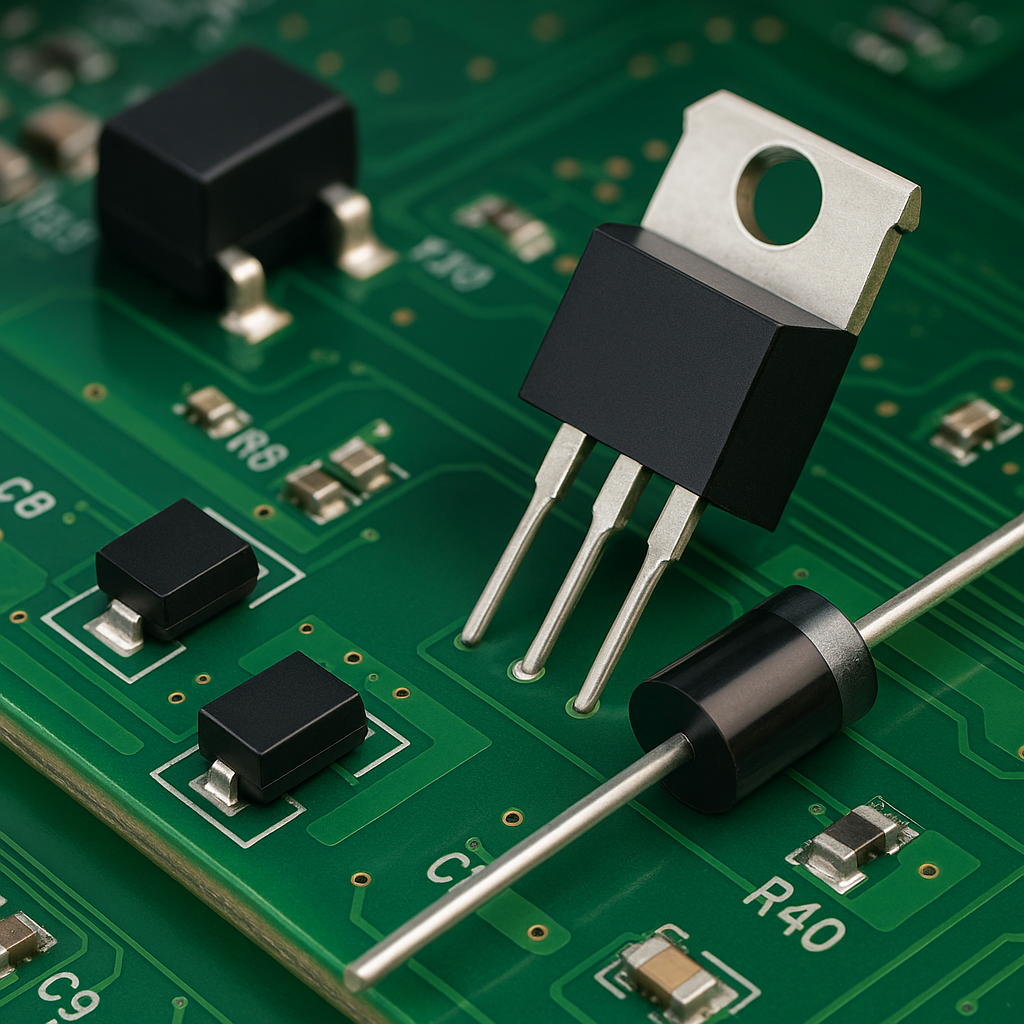Egy nagysebességű alkatrész diadalútja
A gyorsabb és hatékonyabb elektronikai eszközök készítésének versenyében a Schottky-diódák a kevéssé ismert hősként tűntek elő. Ezek az apró alkatrészek, amelyek gyors kapcsolási képességükkel és minimális feszültségveszteséggel való működésükért váltak híressé, elengedhetetlenné váltak egy olyan világban, ahol a teljesítményt ezredmásodpercek és millivoltok határozzák meg. Az okostelefonoktól, amelyeket a zsebünkben hordunk, egészen a zöldépületeket működtető napelemekig, a Schottky-diódák a háttérben dolgoznak, biztosítva a zavartalan energiaáramlást és nagy sebességű működést. Ahogy a technológia fejlődik, szerepük még fontosabbá válik, bebizonyítva, hogy még a legkisebb alkatrészek is meghajthatják a legnagyobb újdonságokat a nagy sebességű alkalmazások terén.
Az egyedi felépítés: Fém találkozik félvezetővel
Egy Schottky-diódának a hatékonysága mögött egy egyszerű, ugyanakkor briliáns kialakítás húzódik: egy közvetlen átmenet a fém elektródából és egy félvezető anyagból (általában n-típusú szilícium). Ez a fémből és félvezetőből álló határfelület megszünteti a hagyományos diódákban található p-n átmenet szükségességét, és ezáltal alapjaiban változtatja meg az eszköz viselkedését. Amikor feszültséget kapcsolnak rá, az elektronok majdnem pillanatnyi módon áramlanak át ezen a határon, akadályoztatva a p-n diódákban kialakuló vastag letöltődési zóna miatt. Ennek a nagy letöltődési rétegnek a hiánya a sebességük kulcsa – a kapcsolási időket nanoszekundumban mérik, így ideális választást jelentenek olyan áramkörökben, ahol a gyors be- és kikapcsolás elengedhetetlen.
Ez a szerkezeti előny csökkenti a dióda kapacitását is, ami a magas frekvenciájú alkalmazásokban meghatározó tényező. Az alacsonyabb kapacitás azt jelenti, hogy a dióda képes gyorsan változó jelekre késleltetés nélkül reagálni, ez pedig rendkívül értékes a rádiófrekvenciás (RF) áramkörökben és nagy sebességű adatátviteli rendszerekben. Akár 5G bázisállomásokról, akár radarberendezésekről legyen szó, a Schottky-diódák azon képessége, hogy lépést tartanak a villámgyors jelváltozásokkal, minimális torzítást és maximális hatékonyságot biztosít.
Alacsony feszültségesés: A hatékonyság újraértelmezve
A sebesség túlmutatva, a Schottky-diódák kiemelkedően jól működnek az energiapazarlás minimalizálásában. Ezzel szemben a hagyományos diódáknak általában 0,6–0,7 V közötti előremeneti feszültségesésük van, míg a Schottky-típusok gyakran csupán 0,15–0,4 V esés mellett működnek. Ez az úgy tűnő apró különbség jelentős energia-megtakarítást eredményez, különösen nagy teljesítményű vagy akkumulátorral működő eszközök esetén.
Az áramforrásokban például egy alacsonyabb feszültségesés azt jelenti, hogy kevesebb energia alakul át hővé, csökkentve a nagyméretű hűtőborda és hűtőventilátorok szükségességét. Ez nemcsak könnyebbé és kompaktabbá teszi az eszközöket, hanem meghosszabbítja élettartamukat is a hőterhelés csökkentésével. Hordozható elektronikai eszközökben, mint például laptopok és okostelefonok, a csökkentett teljesítményveszteség közvetlenül hosszabb akkumulátor-üzemidőt eredményez – egy olyan funkció, amelyre a fogyasztók egyre nagyobb hangsúlyt helyeznek. Még nagyobb rendszerekben, például ipari tápegységekben vagy elektromos járművek töltőállomásaiban is, ezeknek a kis feszültségmentesítéseknek a halmozott hatása összeadódik, csökkentve az üzemeltetési költségeket és javítva a fenntarthatóságot.
A sokoldalú alkalmazások a különböző iparágakban
A sebesség és az hatékonyság kombinációja miatt a Schottky-dióda elengedhetetlen része lett különféle területeknek, melyek mindegyike sajátos tulajdonságaikat használják ki konkrét kihívások megoldására. Az autóiparban ezek beépülnek az elektromos és hibrid járművekbe, ahol a diódák feladata a teljesítmény átvitele az akkumulátorok, motorok és töltőrendszerek között. Gyors kapcsolási képességük pontos energiatermelést biztosít, amikor csak szükség van rá, javítva ezzel a gyorsítási reakciót és csökkentve a töltési időt.
A megújuló energia rendszerekben a Schottky-diódák kritikus szerepet játszanak a napelemek egyenirányítóiban. A napcellák által generált váltóáramot (AC) minimális veszteséggel alakítják át egyenárammá (DC), maximalizálva a napenergiából nyert felhasználható villamos energia mennyiségét. Hasonló módon a szélturbinákban stabilizálják a teljesítmény kimenetelt, biztosítva az állandó energiaellátást a hálózatra.
A Schottky-diódák elengedhetetlenek a távközlési szektorban is. Rádiófrekvenciás keverőkben és detektorokban használják őket, ahol nagy frekvencia-válaszuknak köszönhetően képesek gyenge jeleket feldolgozni anélkül, hogy zajt okoznának. Ez kritikus fontosságú a tiszta kommunikáció fenntartásához mindenhol, legyen szó műholdas kapcsolatokról vagy Wi-Fi routerekről, ahol a jelminőség elsődleges.
Innovációk, amelyek a jövőt formálják
Ahogy nő az igény a gyorsabb és hatékonyabb elektronikai eszközök iránt, úgy tolják az elektronikai gyártók a Schottky-diódák tervezésének határait. Az új anyagok kerülnek előtérbe: a gallium-nitrid (GaN) és a szilícium-karbid (SiC) felváltja a hagyományos szilíciumot, még alacsonyabb feszültségesést és magasabb üzemeltetési hőmérsékleteket biztosítva. Ezek a széles sávtiltású félvezetők nagyobb teljesítménysűrűséget bírnak el, így ideális választást nyújtanak a következő generációs elektromos járművekhez és nagy teljesítményű számítógéprendszerekhez.
A csomagolásban történt fejlesztések szintén javítják a teljesítményt. A miniatürizált felületszerelt tokok csökkentik a parazita induktivitást és ellenállást, tovább javítva a kapcsolási sebességeket és a hőkezelést. Eközben az „rendszerchipre” (SoC) integrálás Schottky-diódákat más alkatrészekkel, például tranzisztorokkal és kondenzátorokkal egyetlen chipbe kombinálva. Ez az integráció egyszerűsíti az áramkörtervezést, csökkenti a méretet és a költségeket, így a magas sebességű technológia elérhetőbbé válik különböző iparágakban.
Összegzés: A nagy sebességű elektronika alapköve
Kezdetben specializált alkatrészként megjelent Schottky-diódák ma már meghatározó szereplőkké váltak, és bizonyítottan nélkülözhetetlenek a gyorsabb, hatékonyabb és megbízhatóbb elektronikai megoldások terén. Egyedülálló kombinációt nyújtanak gyors kapcsolással, alacsony feszültségeséssel és sokoldalúsággal, ezzel modern technológia alapkövévé válva, lehetővé téve innovációkat mind a okostelefonokban, mind a megújuló energiaellátási rendszerekben.
Ahogy az mérnökök folyamatosan újraírják a lehetséges határait—akár MI-ben, IoT-ban vagy elektromos mobilitásban—Schottky-diódák kétségkívül központi szerepet játszanak majd. Az anyagok és tervezés terén folyó fejlesztéseknek köszönhetően ezek az apró alkatrészek tovább fognak fejlődni, biztosítva, hogy a jövő nagy sebességű áramkörének szívében maradjanak. Egy olyan világban, ahol a sebesség és hatékonyság jelenti a haladást, a Schottky-dióda több, mint csupán egy alkatrész – az innováció egyik mozgatórugója.

